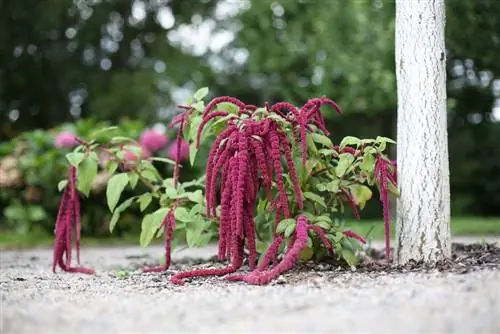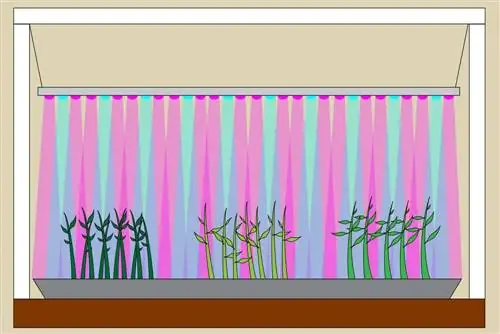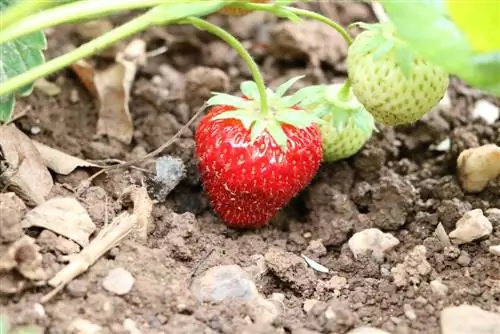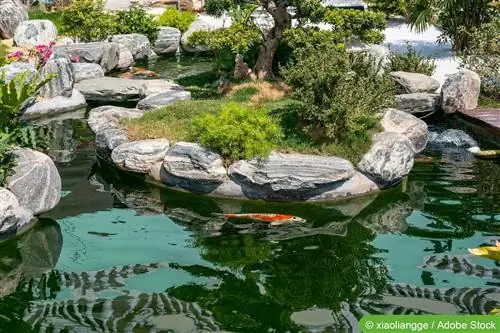- Author admin [email protected].
- Public 2023-12-17 03:39.
- Last modified 2025-01-24 12:45.
The amaranth or foxtail is one of the oldest cultivated plants that was forgotten a long time ago. Recently the foxtail has been experiencing its renaissance and can be found more and more in home gardens.
Amarant varieties are available in a wide variety of colors, from a rich green to varieties with red foliage. The amaranth can be planted in the garden as an ornamental plant in decorative beds or as a food plant in the vegetable garden.
Selection of location
The foxtail is a very undemanding plant that thrives in any garden soil. Although the plant is not hardy, individual seeds may survive the winter. Particularly in mild winters and due to the low demands on the location, it can happen that the amaranth spreads in the garden in spring. Depending on the genus and location, the plant can grow between a few centimeters and almost two meters tall. If you want to ensure that the amaranth thrives and grows to a nice size, you should choose a location that is as sunny as possible. The soil can be improved with manure or compost, which also promotes growth. If the soil is very dense and impermeable to water, the soil must be loosened accordingly before planting or sowing. The amaranth does not tolerate waterlogging very well; on the contrary, longer dry periods are less problematic for the plant than long periods of rain. If the soil is low in lime, it can be improved by adding rock dust. Because the amaranth grows quickly in good conditions, the soil quality must be constantly maintained so that growth is not stunted.
Sowing and cultivation
The amaranth is propagated by sowing, which is very successful:
- The amaranth can be grown in a sheltered location indoors in early spring and planted outdoors after frost.
- Sowing directly outdoors only takes place from mid to late May, as the seeds need enough warmth to germinate.
- The seedlings are also susceptible to late frosts, which is why plants grown indoors should gradually be acclimated to the temperatures outside.
- This also applies to plants that are purchased from specialist retailers, as frost does not necessarily have to kill the plant, but it can significantly slow down growth.
- If larger plants are planted in the garden, care should be taken to prepare a correspondingly large planting hole into which, for example, compost can be filled.
- Especially with larger plants, it is important that they are watered sufficiently at first, but later only moderately, so that they root well.
- Good rooting is especially important for tall varieties, as a good stand is necessary at a height of almost two meters.
The amaranth can be planted as a solitary plant in a perennial bed; it looks particularly good in a group. When sowing or planting out, care should be taken in the group to ensure that the individual plants have enough space to grow.
Care
The amaranth not only has few demands on the location, the plant is also very undemanding in terms of care. The plant is supplied with liquid fertilizer every two to three weeks. Depending on the later use, this can be a commercial fertilizer for perennials or compost or self-made manure in the vegetable patch. Plants with a height of approx. 20 to 50 cm should be supported, especially if they have not yet reached their full height. Strong winds and heavy rain can otherwise bend the plant or individual branches can break off. The support should be sufficiently high and well anchored in the ground, as the flowers and fruit heads of the foxtail in particular have a lot of weight. Dead leaves should be removed regularly in rainy years so that they do not begin to rot.

If you only want amaranth as a decorative perennial in the garden, you can remove the fruit stalks after flowering. This takes some of the weight off the plant. A few fruit heads can remain on the plant to ripen, which provides seeds for the next year. If the amaranth leaves or their seeds are eaten as a vegetable, it is advisable to provide additional support to the fruit heads in autumn and to protect them from birds. These also like the seeds and often ensure that the foxtail spreads randomly in the garden.
Pests and diseases
The only pest that could be dangerous to amaranth are aphids. If the plant is not eaten, these can be combated with a commercially available product. Otherwise, beneficial insects should be encouraged in the garden or natural remedies such as horsetail extract should be used. If waterlogging occurs, the plant may be affected by root rot. In this case, the plant should be disposed of and the soil should be better prepared before replanting.
The amaranth is an easy-care and versatile plant. Varieties with tall growth in particular look good in the garden or in the entrance area. Its low requirements make it suitable for gardens where there is little time for care, as the plant can easily tolerate a vacation lasting several weeks without watering.
What you should know in brief
Profile
- Amaranthus is a genus of plants in the foxtail family.
- The plant gets its name from the inflorescences that look like foxtails.
- There are at least 100 different species in this genus.
- The foxtail is found everywhere on earth except for the Arctic. Almost without exception it is an annual.
- The plants with hanging inflorescences are best known. They are often used as planting for balcony boxes.
- The flower spikes of the foxtail come in different colors, from red to green to reddish brown.
- Amaranthus blooms from June to October. Depending on the variety, the plant can grow up to 1.50 m high.
- The foxtail is very sensitive in the cold. In spring it should be protected from late frosts.
- The foxtail is propagated by sowing. You sow it in the cold frame or directly outdoors.
Usage
Amaranthus caudatus, also called Inca wheat, comes from the Andean region and is a pseudo-cereal. It was used as food. Seeds of these plants have been found in tombs in Mexico that are almost 9,000 years old. The amaranth is not only very decorative with its long, hanging dark red inflorescences. Foxtail is gluten-free (grain substitute), has a high lysine content (15%) and is more valuable than milk protein. Many nutrients and trace elements, especially calcium, iron, zinc and magnesium, make this plant very attractive for vegans and astronauts. It also contains unsaturated fatty acids and vitamins B1 and E. We grow it as garden foxtail.
In the garden
The tall foxtail varieties are well suited for cottage gardens. The low ones look very good in pots, hanging baskets and balcony boxes. A location in full sun and sheltered from the wind is important. The soil should be permeable, moist and nutrient-rich. During dry periods the plant needs to be watered well. To ensure dense blooms, remove spent inflorescences and fertilize regularly once a week.
If you cut young plants back, they will grow bushier.

Some species, such as the rough-haired foxtail, are now considered weeds and are real pests. They multiply uncontrollably and can take root anywhere. Up to a million seeds can spread from a single plant. It is best to combat them before they bloom. In the garden, the plants can be removed relatively easily by pulling them out. Under no circumstances should ripe fruit stalks be composted!






